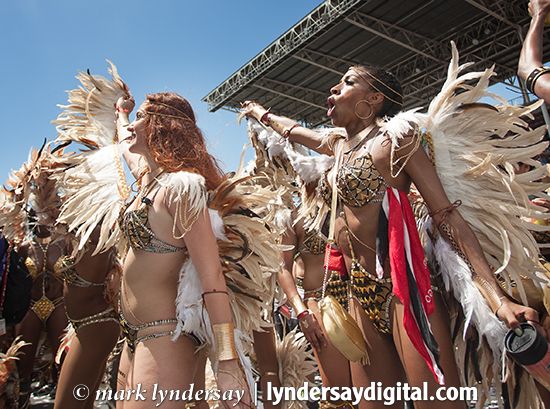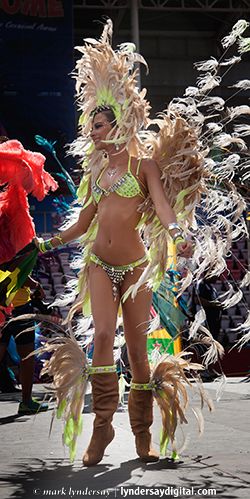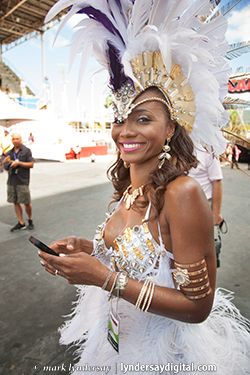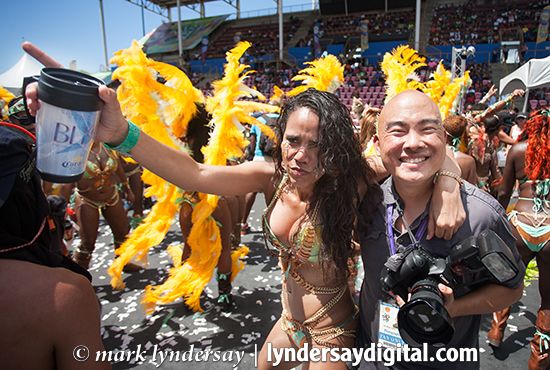Beyond Socadrome
24/02/15 20:45 Filed in: BitDepth+
Reporting on the second installation of the Socadrome at the Jean Pierre Complex.
Originally published in the Trinidad Guardian on February 24, 2015

Masqueraders in Anya Ayoung-Chee’s section in Tribe react to the designer’s presence on a nearby truck at the Socadrome.
For 2015, the team behind the Socadrome, supported by Tribe, Bliss and Yuma and publicly fronted by Tribe bandleader Dean Ackin and communications professional Danielle Jones-Hunte, reported a doubling of attendance at the event.
That didn’t come close to filling seats at the Jean Pierre Complex, but it’s a positive indicator for the event in just its second year.
The Socadrome was originally designed as a non-competitive party venue for the large bands that pooled their resources to pay for the venue and the amenities.
A big change in focus for 2015 was a greater effort at staging a show for the audience that did turn up and from the start of the event, at around 8:45am, there was a non-stop flow of Carnival until 1:00pm.
 Miss Jamaica, Kaci Fennell, on the Socadrome stage with Bliss.
Miss Jamaica, Kaci Fennell, on the Socadrome stage with Bliss.
First on the stage was Lionel Jaggessar’s Red Indian band, followed by the children’s band Spoiled Rotten Kids and a remarkable showing by Rosalind Gabriel’s band, which had almost doubled in size with the addition of adult players intent on putting on a performance appropriate to the sailor traditions that the bandleader saluted this year.
Just minutes after Gabriel’s band left, the first of the big bands, Yuma appeared with their presentation, Reign, followed by Bliss, with Blue and Tribe, with their presentation, Wings of Desire.
Tribe alone would cross the stage for almost an hour and a half, challenging the capacity of the band’s internal security to maintain control.
I left after that, but photographer Peter Lim Choy stayed on for another three hours.
He reports a 40 minute halt in proceedings between Tribe’s departure and the performance of the Calypso Youth Monarch, Aaron Duncan, then things picked up again with a surprise appearance by the band D’Krewe, a small group of traditional Carnival characters, then a very well received extempo performance between National Extempo Monarch Lingo accompanied by Black Sage.
Brimblers Steelband would perform after that along with a performance by Fareid Carvalho in his King of Carnival costume, followed by Roy Cape All Stars. Lim Choy would leave the venue at 3:00pm, during that band’s performance.
According to Mrs Hunte, Brimblers, Lingo, Duncan and Cape’s All Stars were all paid performers for the event, which increased costs.
 Socadrome spokesperson Danielle Jones-Hunte co-ordinates the event on her mobile phone on Carnival Tuesday.
Socadrome spokesperson Danielle Jones-Hunte co-ordinates the event on her mobile phone on Carnival Tuesday.
"What's needed is a look at how participation can be increased without negatively impacting on any of the stakeholders involved,” explained Hunte.
“Dkrewe and Rosalind came on board and we anticipate growth and interest to increase for 2016 once we have approval and can plan earlier.”
“We had more participation than last year and expect it to grow should we do the Socadrome again.”
Balance at the Socadrome is one of the pressing points that plagues the project.
Accused of being an exclusive private enterprise, the organisers of the Socadrome dropped the admission price to $10, an unheard of price point for a major Carnival event in this century, and put out even more money for non-costumed acts while inviting more bands to participate.
In the face of open official hostility toward photographers and videographers at official NCBA events, expressed in oppressive rights demands, the Socadrome threw open its doors to otherwise disenfranchised image makers.
That avalanche of photographers, added to a high-definition online video stream managed by Carnival TV, met most of the requirements of masqueraders keen to play their mas on a big stage.
But there are still those players who miss the mystique of the Grandstand, even as attendance there diminished to less than a third of the available capacity and the less said about the quality of the video stream from that venue the better.
That isn’t to say that the Socadrome is an unblemished haven for Carnival coverage.
“i am not really fond of Jean Pierre as a venue,” said Lim Choy, “the sun is brutal and there is not much shade to be found.”
He also lamented the transplanting of poor stage management from the Grandstand, another matter of balance that the Socadrome management must wrestle with.
If the organisers want video and photographic coverage that impresses future players and online observers, they will face the challenge of changing modern masquerader expectations of meeting a phalanx of cameras onstage ready to capture demonstrations of their “worst behaviour.”
“I think more policing of media on stage needs to be done,” Lim Choy said. “Perhaps a media line that they can’t cross so that masqueraders can at least get on stage before they get rushed by photographers.”
“I’d also like to see something like a media centre where we could set up laptops and have access to the internet to post stuff, but all in good time, I guess.”
Into the considerable gaps in interest and engagement being engineered by the NCBA on Carnival Monday and Tuesday, the resurgence of Carnival downtown and the incremental growth and pervasive media presence of the Socadrome point to a changing idea of a parade route and the possible expiration of the idea of judging points in favour of entertainment hotspots and centres.
“We have to do a full review but feedback has been overwhelmingly positive,” said Hunte.
“Spectators really liked the fast moving show that featured various elements of mas and masqueraders enjoyed the flow of the bands through the Socadrome with no congestion affecting their Carnival experience.”
“We hope that the regulations will change to allow other bands and individuals (competing costumes, kings and queens) to participate without fear of being penalized.”
“The Socadrome has immense potential and we believe the public is warming to it.”
It’s a position that photographer Peter Lim Choy endorses.
I consider it an opportunity to help create a space that includes photographers,” he explained.
“The organizers are interested in dialogue on how things can improve going forward. I support the idea of the Socadrome.”

Photographer Peter Limchoy and designer Jeunnane Alkins embrace in Tribe’s Wings of Desire on the Socadrome stage.
I've been writing about Carnival issues for decades now, but the stories over the last six years have been particularly relevant. You can find them here.

Masqueraders in Anya Ayoung-Chee’s section in Tribe react to the designer’s presence on a nearby truck at the Socadrome.
For 2015, the team behind the Socadrome, supported by Tribe, Bliss and Yuma and publicly fronted by Tribe bandleader Dean Ackin and communications professional Danielle Jones-Hunte, reported a doubling of attendance at the event.
That didn’t come close to filling seats at the Jean Pierre Complex, but it’s a positive indicator for the event in just its second year.
The Socadrome was originally designed as a non-competitive party venue for the large bands that pooled their resources to pay for the venue and the amenities.
A big change in focus for 2015 was a greater effort at staging a show for the audience that did turn up and from the start of the event, at around 8:45am, there was a non-stop flow of Carnival until 1:00pm.

First on the stage was Lionel Jaggessar’s Red Indian band, followed by the children’s band Spoiled Rotten Kids and a remarkable showing by Rosalind Gabriel’s band, which had almost doubled in size with the addition of adult players intent on putting on a performance appropriate to the sailor traditions that the bandleader saluted this year.
Just minutes after Gabriel’s band left, the first of the big bands, Yuma appeared with their presentation, Reign, followed by Bliss, with Blue and Tribe, with their presentation, Wings of Desire.
Tribe alone would cross the stage for almost an hour and a half, challenging the capacity of the band’s internal security to maintain control.
I left after that, but photographer Peter Lim Choy stayed on for another three hours.
He reports a 40 minute halt in proceedings between Tribe’s departure and the performance of the Calypso Youth Monarch, Aaron Duncan, then things picked up again with a surprise appearance by the band D’Krewe, a small group of traditional Carnival characters, then a very well received extempo performance between National Extempo Monarch Lingo accompanied by Black Sage.
Brimblers Steelband would perform after that along with a performance by Fareid Carvalho in his King of Carnival costume, followed by Roy Cape All Stars. Lim Choy would leave the venue at 3:00pm, during that band’s performance.
According to Mrs Hunte, Brimblers, Lingo, Duncan and Cape’s All Stars were all paid performers for the event, which increased costs.

"What's needed is a look at how participation can be increased without negatively impacting on any of the stakeholders involved,” explained Hunte.
“Dkrewe and Rosalind came on board and we anticipate growth and interest to increase for 2016 once we have approval and can plan earlier.”
“We had more participation than last year and expect it to grow should we do the Socadrome again.”
Balance at the Socadrome is one of the pressing points that plagues the project.
Accused of being an exclusive private enterprise, the organisers of the Socadrome dropped the admission price to $10, an unheard of price point for a major Carnival event in this century, and put out even more money for non-costumed acts while inviting more bands to participate.
In the face of open official hostility toward photographers and videographers at official NCBA events, expressed in oppressive rights demands, the Socadrome threw open its doors to otherwise disenfranchised image makers.
That avalanche of photographers, added to a high-definition online video stream managed by Carnival TV, met most of the requirements of masqueraders keen to play their mas on a big stage.
But there are still those players who miss the mystique of the Grandstand, even as attendance there diminished to less than a third of the available capacity and the less said about the quality of the video stream from that venue the better.
That isn’t to say that the Socadrome is an unblemished haven for Carnival coverage.
“i am not really fond of Jean Pierre as a venue,” said Lim Choy, “the sun is brutal and there is not much shade to be found.”
He also lamented the transplanting of poor stage management from the Grandstand, another matter of balance that the Socadrome management must wrestle with.
If the organisers want video and photographic coverage that impresses future players and online observers, they will face the challenge of changing modern masquerader expectations of meeting a phalanx of cameras onstage ready to capture demonstrations of their “worst behaviour.”
“I think more policing of media on stage needs to be done,” Lim Choy said. “Perhaps a media line that they can’t cross so that masqueraders can at least get on stage before they get rushed by photographers.”
“I’d also like to see something like a media centre where we could set up laptops and have access to the internet to post stuff, but all in good time, I guess.”
Into the considerable gaps in interest and engagement being engineered by the NCBA on Carnival Monday and Tuesday, the resurgence of Carnival downtown and the incremental growth and pervasive media presence of the Socadrome point to a changing idea of a parade route and the possible expiration of the idea of judging points in favour of entertainment hotspots and centres.
“We have to do a full review but feedback has been overwhelmingly positive,” said Hunte.
“Spectators really liked the fast moving show that featured various elements of mas and masqueraders enjoyed the flow of the bands through the Socadrome with no congestion affecting their Carnival experience.”
“We hope that the regulations will change to allow other bands and individuals (competing costumes, kings and queens) to participate without fear of being penalized.”
“The Socadrome has immense potential and we believe the public is warming to it.”
It’s a position that photographer Peter Lim Choy endorses.
I consider it an opportunity to help create a space that includes photographers,” he explained.
“The organizers are interested in dialogue on how things can improve going forward. I support the idea of the Socadrome.”

Photographer Peter Limchoy and designer Jeunnane Alkins embrace in Tribe’s Wings of Desire on the Socadrome stage.
I've been writing about Carnival issues for decades now, but the stories over the last six years have been particularly relevant. You can find them here.
blog comments powered by Disqus

